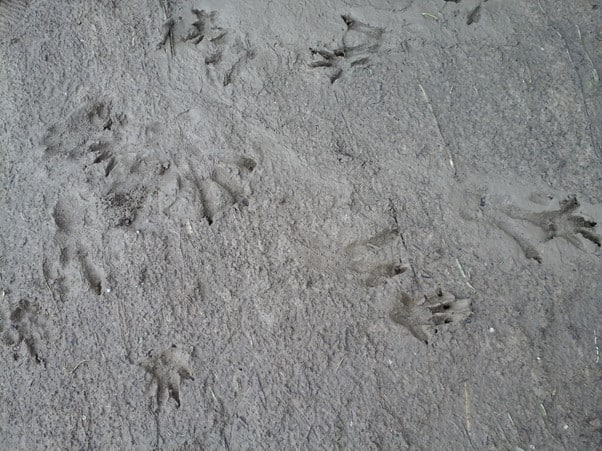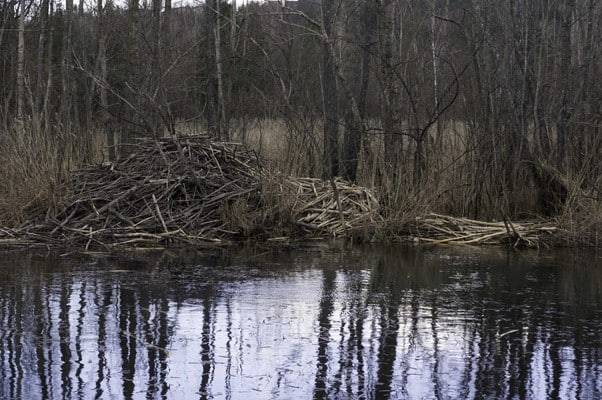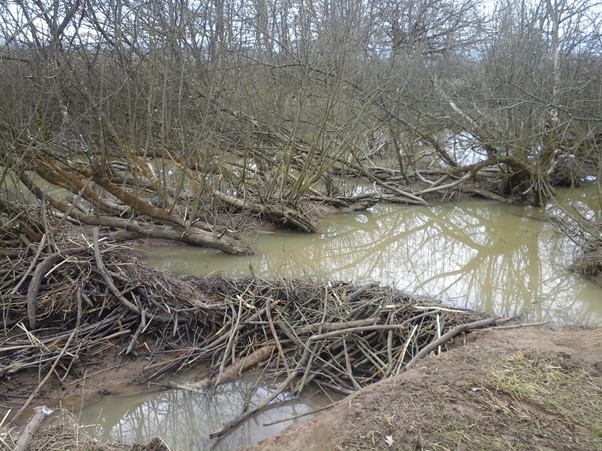It has always been easiest for me to write about things that are familiar or that I went through on my own. That is why I am also starting this blog with my experience. My sister and I like to ride our bikes around our hometown. Occasionally we stop at a pond which in late spring is already teeming with life. That day was no different. The frogs were croaking, swarms of insects were hovering around, and many birds were flying over the water surface. But then we noticed something we had never seen before. From a distance, it looked as if someone was smashing over a tree and wanted to cut it down. But when we got closer, we found that it looked bitten, as if there were small “knives” at work. My suspicions were confirmed by my colleague Klemen Juršič, who has a master’s degree in Ecology and Biodiversity and knew exactly what he was looking at. He told me that the suspect measures around 100 cm, weighs about 25 kg, and carries a brown coat with a leather veil. He also mentioned that the suspect would have orange teeth and a swimming membrane on his hind legs. Of course, he had a beaver in mind.

Beavers chew trees for food and building material, leaving traces on the trunks (photo by Tamara Kovačič).
The European beaver (Castor fiber) is the largest European rodent. Both males and females are about the same size and have flattened, broad, and scaly tails that help them steer in the water. A Beaver’s body is stocky and is covered with thick brown fur, protecting it from the cold. Their highly prized fur was the reason for their popularisation with hunters in the 18th century. Beavers were also hunted for their meat, which many people would eat on Lent days before Easter. They believed that beavers lived in water, just like fish, so their meat could be eaten even during a fast. This, as well as the cutting of riparian forests for firewood, resulted in beavers being exterminated from Slovenia around the 18th century.

Beaver’s footprints in the mud are fairly easy to recognize as it has a swimming membrane between all five toes of his hind legs (photo by Klemen Juršič).
The populations of the European beaver that inhabit Central Europe today are a mixture of different subspecies. This is due to the intensive introduction of beavers in the 20th century as an effort to increase their numbers declined because of hunting. The beaver reappeared in Slovenia after 1998 in a natural way, as a consequence of the Croatian campaign for the repopulation of beavers. It started with only 85 specimens. From this successful repopulation of beavers in Croatia, the later appearance of beavers in Slovenia in the Sava, Drava, and Mura rivers originates. Today the beaver is also found in other rivers of eastern and south-eastern Slovenia (e.g., the Kolpa, Krka, and Sotla rivers with their tributaries). With virtually no beavers in Slovenia until 1998, these animals still managed to raise their numbers to over 80 beaver families in just 20 years, which is a great success.

The most recognizable activity of beavers is certainly the construction of dams and lodges (photo by Klemen Juršič).
We consider the beaver as an ecosystem engineer. He is a master builder that helps maintain wetlands and other water systems. Also, many organisms that live in such environments benefit from his actions. The beaver is an herbivore, so he feeds on grass, trees, and bushes. He cuts down the trees and bites the trunks, and branches into pieces that are about the same length, and pulls them into a pile by the water. Unfortunately, beavers often come into conflict with humans by digging canals, building dams, and gnawing on plants. This often results in cut-down or damaged trees, flooded agricultural land, and land subsidence. To prevent these unwanted activities, people can wrap tree trunks with nets or prevent beavers from accessing fields with electric fences. It is better to leave already felled trees alone, as beavers will not start felling new ones while they are still feeding on the current tree. These methods are non-invasive and allow beavers and humans to coexist.

The pools left behind by beavers offer habitat to many aquatic organisms (photo by Klemen Juršič).
We need to understand that just as this new-old neighbour may be something surprising to us, for a beaver, this environment to which he returns is also quite different from the one in which he once lived. Centuries ago, there was much less agriculture in Slovenia, and we certainly did not know the industrial areas in the same sense we do today. These issues and the role of the beaver as a key animal species through his engineering activities in aquatic ecosystems are something the researchers at the LIFE Beaver project are trying to address. The project applicant is Lutra, the Institute for the Preservation of Natural Heritage from Slovenia. Through their research, they seek to understand the impact of beaver on wetland conservation and on reducing and preventing flooding and erosion. They also want to make the public aware of the activities of this amazing rodent and educate various stakeholders about the many positive impacts that the beaver has.
It should also be noted that beavers, like many other animals, do not care about our borders drawn on the map. They have already shown this with their spontaneous expansion from Croatia to Slovenia. Where will the current take them next?


